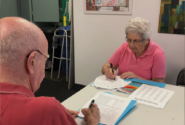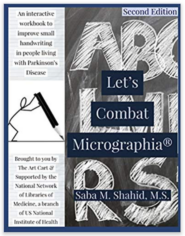Saba Shahid-Moir, Art Therapist
 Chief Smiling Officer of the Art Cart, Saba Shahid-Moir, MS, has made it her mission to help those who can’t smile so easily anymore due to complications from Parkinson’s disease. She has combined the world of art and science to create Smile Through Art Workshops, which has aided hundreds of patients with Parkinson’s. Based out of Massachusetts Saba and her husband, Chad Moir, lead several programs that assist Parkinson patients to regain better mobility of their muscles. Saba’s Smile Through Art workshops are evidence-based and help patients alleviate and counteract Parkinson symptoms. We sat down for tea and crepes to discuss the fine art of creating a program from scratch and why smiling is an important component to the workshops.
Chief Smiling Officer of the Art Cart, Saba Shahid-Moir, MS, has made it her mission to help those who can’t smile so easily anymore due to complications from Parkinson’s disease. She has combined the world of art and science to create Smile Through Art Workshops, which has aided hundreds of patients with Parkinson’s. Based out of Massachusetts Saba and her husband, Chad Moir, lead several programs that assist Parkinson patients to regain better mobility of their muscles. Saba’s Smile Through Art workshops are evidence-based and help patients alleviate and counteract Parkinson symptoms. We sat down for tea and crepes to discuss the fine art of creating a program from scratch and why smiling is an important component to the workshops.
- What originally piqued your interest to learn and work with Parkinson patients? And how did you come up with the concept of art therapy, The Art Cart, for Parkinson’s patients?
When I started the Art Cart, I was originally working a corporate job and also applying for medical school. While I waited to hear back, I had this realization that working behind a computer is way too boring and I missed being with people and patients. I always saw there was a lack of treatment for patients’ plan of care and incorporating art into it. What drew me to learn more about Parkinson’s disease was because my mother-in-law passed away from complications due to Parkinson’s. It’s a movement disorder so a lot of it has to do with fine motor and gross motor skills, depression, and the lack of inability to write. These are all symptoms. When you tie art in, it can improve these symptoms or if you use the techniques you can still use the hand that tremors. And that is how it got started because art can be incorporated into different areas of movement. With Parkinson’s being a moving disorder, there are lot of thing I want to teach that focus on, “Hey, this is how you can use art to better your symptoms.”
- What components of art and art therapy aid Parkinson’s patients and their motor skills?
The reason we call our workshops Smile Through Art is because facial masking and the inability to smile is a symptom of Parkinson’s. Many times, the disease gets misunderstood because they have that facial masking problem. One of the first things we do at every class is to force a smile because forcing a smile causes the same physiological impact in your brain. It causes those dopamine channels to open, which makes you feel good and better. It’s something simple, but it can help.
We also use anything from paint to household items like Q-tips or paperclips to improve fine motor skills. Every workshop that a patient attends is different. They are working on different symptoms.
Art can help with depression. We have published research that shows ninety-eight percent of active workshop participants have an increase in positive mood. The other two percent stays the same. I’ve never had someone come to our workshop and have their mood decrease, which shows how art and the activities impact them positively.

We also make sure our activities occur over the weekend because spouses and caregivers still have full-time jobs—so we are accommodating for their schedules. It also depends on the demographic we are working with because there is early onset Parkinson’s, which is ages fifty and under, or later onset, which is more senior citizens. So each workshop depends if the patient is still working or if their spouse works. One thing we do in our program is ask their spouse or family member to join in so they can work together. There’s been many times where you catch the spouse watching their partners with admiration at what can be accomplished. It’s a bonding experience— they forget about Parkinson’s for a little while and they’re working together.
- What are some essential art exercises and activities that are most important in developing motor skills?
With tremors, people are afraid to use a particular hand so we teach them to finger paint with that hand. They’re exercising their fingers and we are teaching them different ways to move so they are using their entire hand. We are retraining the brain, but patients aren’t looking at this as therapy, but as a creative project so they’re inclined to participate. When they finger paint, they’re able to create something with a hand they didn’t think they could use and at the same time also exercising their fine motor skills. We work with paint, clay, household items, and different types of paper.
- Do you have a favorite art activity you like to do with participants?
Finger paint is generally our first project because a lot of people who come to our workshops typically haven’t done anything creative in years. Many people with Parkinson’s experience tremors so when they’re able to do an activity they can see how art is used to help themselves.
- Your own work has been showcased before. Can you tell me which mediums of art you like to work with?
I personally work with acrylic and spray paint. I really like spray paint. I haven’t done it in a while, but I started doing paint projects with my son. I really like abstract. I grab a brush and just go and see where it takes me. Sometimes it could turn into a scenic painting or other times different colors mesh together and, in my mind, it creates a story. If you look at it, it could mean something else, and I think that’s a beautiful thing about art, especially when working with Parkinson patients. In art, they can see that. They used their brainpower, their creativity, and see what comes from it. It’s always important to remember an art piece can mean something different to everyone. They create a story.
- What are some of your inspirations? What is your own process?
I like the feeling of being focused on something and forgetting everything that is around. I really like that process. When it comes to patients, I can see that process within them. They leave all their worries and stress at the door. All that matters to them is their painting or their creative pieces. I think that’s really beautiful how you can make art and forget everything else and get so in tuned with it to create. For my own process, I like to have the paints set up next to me, with the canvas in front of me in a well-lit room or with natural light, then just go at it. It’s not really a process because I think with art you can’t be very structured. I think it’s important to give yourself the ability to be free.
- You published the book Let’s Combat Micrographia. Micrographia is a disorder that features abnormally cramped or progressively smaller handwriting that’s associated with neurodegenerative disorders—also a common symptom of Parkinson’s. Can you tell me a little more about the research process for this book? Why is it important?
There is edition one and two, which just came out last year. Basically, the book came about when I started working with Parkinson’s patients and I saw Micrographia is an area with nothing to help people. When you think of handwriting—even something as simple as signing your name, that’s very liberating. People with Parkinson’s are unable to do something so simple, but they can reclaim it through exercises within this book. Writing is an art form if you think about it. The research behind it is similar to what we do through our art workshops by having an eight-week “Let’s Combat Micrographia” workshop. They were very intensive. People that had trouble with writing would come in and retrain their brain how to write. We are doing different exercises where we write the alphabet really large in the air and say them out loud.

Another thing with Parkinson’s is a symptom of a soft voice, so when you speak loudly, you are exercising those vocal cords. We ran six different series of workshops in Massachusetts with a total of between eighty to one-hundred patients we worked with. We took the data from there to create the first edition of the book. The first few workshops were experimental, and we saw what worked and what didn’t. It was an amazing and intensive process. It also depends on what people put into it because there is homework that participants need to complete and daily exercises such as journaling to get them to start writing again and train their brain.
When we’re in kindergarten or first grade, we first learn how to write—you do the basics—so in the workshops, we go back to those basics. Simple things like holding a pen or pencil, and using different writing aids, could help increase the surface area. Someone with the disease that experiences tremors or shakes has a hard time holding a skinny pen or pencil. So using writing aids gives them more confidence. We take it a step further by teaching them how to control the pen by doing lines and tracing over letters, and it helps rebuild that confidence and even makes connections in their brains. If they stick to the homework, the results are amazing. Patients have told me they notice an improvement in their muscle memory. They take before-and-after pictures of their writing.

- Can you tell me more about your new training series for professionals related to Micrographia? Will you incorporate elements of art with the trainings? What are the most important components you hope to convey within these trainings?
We worked with the US National Library of Medicine for the second edition and we had a whole medical advisory board of physical therapists, occupational therapists, and movement disorder specialists that reviewed the curriculum. It was very exciting to have the support and the validation of the Library of Medicine. From the second edition, we created a curriculum for professionals. People can attend training and material is given to participants on what needs to be done to aid patients on how to relearn writing skills. Participants can bring what they learned back to their own center and teach their Parkinson’s population.
The message we’re trying to get across is you can improve. There are a lot of centers that are working with Parkinson’s patients and trying different programming to help with symptoms. Writing is such a personal ability. Regaining the ability is essentially regaining confidence. They are more than Parkinson’s and can still live their life. Writing is one of those things that will allow them to feel assurance and living better with Parkinson’s instead of feeling burdened by it.
- You previously did a cross-country trip providing workshops and visited fifteen states. You even brought the workshop to Toronto. What was that like, bringing the Art Cart on the road? What were some memorable moments?
It was amazing and it’s been a dream of mine to spread smiles. To be able to do that through our Smile Through Art workshop series was always a goal of mine. It was one of the reasons why I wanted to go into medicine. I’ve worked with so many patients and formed amazing relationships that I don’t think I would have formed if I had  been a doctor and only saw them for a period of time. Being able to travel and bring the program to different communities in the US and Canada was just awesome. One of the reasons why I named it the Art Cart is because I wanted to make it an accessible program for patients. We travel to an environment or community they’re most comfortable in. I have a little trolley called the Art Cart. The really amazing thing is we worked with so many neurologists, movement disorder specialists, and medical professionals that I am right up there with them. There are times where doctors will write scripts to come to our program, which is really cool. After they finish their plan of care, they transition their patients to us, which is a great collaborative effort, or a big team. To take care of a person you need a whole team of people. It’s not just one person and it’s not just medication. We have established ourselves, the Art Cart and DopaFit (Chad’s Parkinson’s movement program that specializes in research and evidence-based physical exercises for people living with the disease), as the industry experts.
been a doctor and only saw them for a period of time. Being able to travel and bring the program to different communities in the US and Canada was just awesome. One of the reasons why I named it the Art Cart is because I wanted to make it an accessible program for patients. We travel to an environment or community they’re most comfortable in. I have a little trolley called the Art Cart. The really amazing thing is we worked with so many neurologists, movement disorder specialists, and medical professionals that I am right up there with them. There are times where doctors will write scripts to come to our program, which is really cool. After they finish their plan of care, they transition their patients to us, which is a great collaborative effort, or a big team. To take care of a person you need a whole team of people. It’s not just one person and it’s not just medication. We have established ourselves, the Art Cart and DopaFit (Chad’s Parkinson’s movement program that specializes in research and evidence-based physical exercises for people living with the disease), as the industry experts.
During our tour, we met with different communities and saw how they did certain things. We also had people travel hours just to come to our workshops. It’s amazing to hear people say they drove then stayed overnight to come to our program. It’s such an amazing thing they come this far.
For the professional series, we are offering to travel to them if they have a solid group and we’ll do the training there. We currently have some things in the works for traveling, but the next step is to create a training program for the Art Cart so people can bring it to their communities.
- What are some future projects you plan to tackle next? More art exhibitions?
Making these trainings successful is a big goal and getting the word out since we are the only ones who are doing this. We want to do more of a national approach so we’re trying to target different centers. Our next annual art exhibit, which features patients’ artwork, is this October, although the venue has not been decided yet. The last one we hosted brought in over 150 art pieces with over 150 in attendance. People lined up outside the door to get in! It’s one of the events that I look forward to because workshop participants invite their families and get dressed up and stand by their work. We have a few people talk about their experience and it’s an overall great event.
* * *
You can find more information on Saba’s Art Cart, her book “Let’s Combat Micrographia,” and the DopaFit facilities on her website www.smilethroughart.com. The site also lists Parkinson’s statistics, upcoming tour dates, and articles on the benefits of art therapy. Her book can also be purchased through the site or on Amazon.
Loumarie Rodriguez is a newspaper reporter in Connecticut and is an MFA candidate at Antioch University. She is the editor-in-chief of the Lunch Ticket literary journal. She is currently working on her novel along with several short stories. In her spare time, she can be found lurking in coffee shops, traveling, or attempting to read several books at once. You can find her on both Twitter and Instagram at @rloumarie26.





